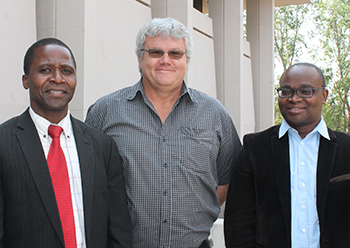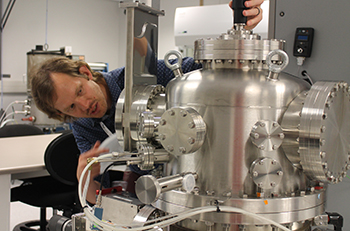State-of-the-art physics equipment and investment in students result in academic success

At the recent nanotechnology facility tour at the UFS,
were, from the left, Dr Mthuthuzeli Zamxaka, SAASTA;
Prof Hendrik Swart, Sarchi Chair in the Department of Physics;
and Xolani Makhoba, Department of Science and Technology.
Photo: Leonie Bolleurs
Nanoscience, which is revealing new properties of very small arrangements of atoms, called nanoparticles, is opening a new world of possibilities. The Department of Physics at the University of the Free State is undertaking fundamental research with potential commercial applications. Its equipment and expertise is giving solid state physics research the edge in South Africa.
The UFS team of researchers and students are passionate about studying planets and atoms, all under one roof. Recently, the department, in collaboration with the South African Agency for Science and Technology Advancement (SAASTA), hosted a nanotechnology facility tour to give the public, learners and the media the opportunity to familiarise themselves with the science of nanotechnology, its origins, potential applications and risks.
Successes of the department
According to Prof Hendrik Swart, Senior Professor in the Department of Physics, the increase in resources since 2008 is playing a big role in the success rate of its research outputs. The Sarchi Chair awarded to Prof Swart in 2012 (bringing with it funding for equipment and bursaries) also contributed to the successes in the department.
The UFS Directorate Research Development also availed funding that was used for bursaries. These bursaries made it possible for the department to appoint 10 post-doctoral fellows, not one of them originally from South Africa.
The investment in people and equipment resulted in researchers and students publishing some 80 articles in 2016. Their work was also cited more than 900 times by other researchers in that year.
Another highlight in terms of the department’s growth in the past 10 years is the new wing of the Physics Building. Physics at the UFS is the only place in sub-Saharan Africa where state-of-the art equipment is found under one roof.

Antonie Fourie, Junior Lecturer in the UFS Department of
Physics, explained to a group of delegates and
members of the media the workings of an electron beam
evaporation system.
Photo: Leonie Bolleurs
Application of research
The department is a unique research facility with equipment that includes the X-ray Photoelectron Spectrometer (for the study of atoms), the Scanning Auger Microscope, as well as the Ion Time-of-Flight Secondary Ion Mass Spectrometer (revealing the chemical bonds in a sample, and drawing maps of the positions of atoms).
One of the areas on which the department is focusing its research, is phosphors. Researchers are exploring light emitting diodes (LEDs) which use less energy, are brighter and provide a wider viewing field. They are also looking into LED displays (LCDs) which are used in flat screens – the phosphors create the different colours and backlighting.
The research on solar cells reveals that phosphors can increase their efficiency by increasing the range of light frequencies which can be converted into electricity. Glow-in-the-dark coatings absorb light in the day and emit it later so cells can charge at night. As glow-in-the-dark phosphors become cheaper and more effective, they can be used as a lighting substitute on the walls of houses, street numbers and stop signs.
Video production of the Department of Physics research and equipment